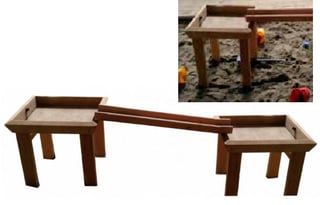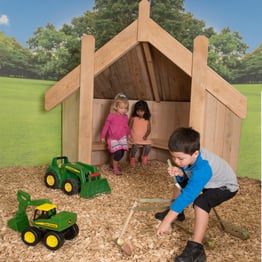"If our children have the opportunity to truly get to know and befriend nature, they will hold a love for it, and as inheritors of this earth, it is essential that this love be fostered. It is in our hands.”
The above quote comes from a 2010 article by Ria Woollams from Tutukaka Coast Playcentre published by Enviro Schools. The article was serving to remind us how important nature is as a teacher and that it can provide learning resources in almost every key area of development our children need. More importantly, it is a value for nature that becomes important with our children.
 But many centres face the challenge of restricted play spaces far removed from streams and forests. Does this mean children at those centres are missing out on key development opportunities?
But many centres face the challenge of restricted play spaces far removed from streams and forests. Does this mean children at those centres are missing out on key development opportunities?
In some cases they are. Researchers from the University of Western Australia found that, unsurprisingly, natural playgrounds created more opportunities for children to develop stronger general motor skills, but there were additional benefits that came from contact with natural materials too.
Contact with nature was cited as improving:
- Cognitive function
- Creativity
- Improved adult interaction
- Reduced ADHD
- Reduced rates of aggression
As we look towards the summer there are increased opportunities for children to be outdoors and it’s important to create an environment that develops these core areas. The same study found that the impact of nature educational and natural settings benefited children in several key areas:
- Children in contact with a natural environment are sick less often and benefit from a stimulated imagination
- Children who play outdoors can be more active and less likely to become overweight
- Children who play in natural settings are less prone to stress, anxiety and depression
- Bullying behaviour is greatly reduced when children are exposed to diverse nature-based play environments
- Symptoms of ADD are greatly reduced after contact with nature
When natural environments cannot be fully achieved then simply encouraging children to interact with natural toys and environments serves as a substitute that can still reward children in similar ways.
 Our mud and water play table is not only made from natural materials but actively encourages children to play with products of nature. The sensory development that comes from materials such as mud and water is well documents and adding further natural elements increases their exposure to nature.
Our mud and water play table is not only made from natural materials but actively encourages children to play with products of nature. The sensory development that comes from materials such as mud and water is well documents and adding further natural elements increases their exposure to nature.
This natural block and plank set also gets children hands-on with natural materials but also helps them understand gravity, pitch, roll and camber. The multitude of layouts for the planks also encourages problem solving and planning, which are great building blocks for development.
Even when the children can’t climb, or scurry over a feature in the outdoors area they can still benefit from a natural solution.
Kid Safe warned that as temperatures increase, so do the risks posed to children. Not only can metal surfaces cause irritations or burns, some plastics can also become very hot. They recommend teachers try to hold their hand on a surface for 5 seconds and if it becomes uncomfortable doing so then to avoid allowing children to play on that piece of equipment.
Wood rarely becomes too hot to play on meaning that a playground that uses more natural products reduces the chance of injury or incident amongst children.
 Shade is also of utmost importance in our New Zealand summers, the day doesn’t even have to be hot for children to burn. Sun shades can greatly reduce this risk but so can creating fun spaces for the children to explore and play in, like this Wharenui.
Shade is also of utmost importance in our New Zealand summers, the day doesn’t even have to be hot for children to burn. Sun shades can greatly reduce this risk but so can creating fun spaces for the children to explore and play in, like this Wharenui.
To learn more about our natural products visit our website.



